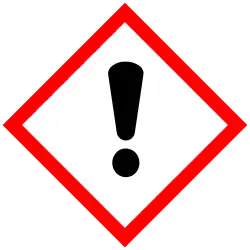3,4-Dimethoxystyrene
 | |
| Names | |
|---|---|
| Preferred IUPAC name
4-Ethenyl-1,2-dimethoxybenzene | |
| Other names
1,2-Dimethoxy-4-vinylbenzene
4-Vinylveratrole 4-Vinyl-1,2-dimethoxybenzene | |
| Identifiers | |
| ChemSpider | |
| ECHA InfoCard | 100.026.330 |
| EC Number |
|
PubChem CID
|
|
| UNII | |
CompTox Dashboard (EPA)
|
|
| |
| Properties | |
| C10H12O2 | |
| Molar mass | 164.204 g·mol−1 |
| Appearance | Yellowish oily liquid |
| Odor | Sweet, floral |
| Density | 1.109 g/cm3 |
| Boiling point | 110–125 °C (230–257 °F; 383–398 K) |
Refractive index (nD)
|
1.571 |
| Hazards | |
| Occupational safety and health (OHS/OSH): | |
Main hazards
|
flammable, toxic |
| GHS labelling: | |

| |
| Warning | |
| H319 | |
| P264, P280, P305+P351+P338, P337+P313 | |
| Safety data sheet (SDS) | MSDS |
| Related compounds | |
Related styrenes;
related aromatic compounds |
styrene, dimethoxybenzene |
Except where otherwise noted, data are given for materials in their standard state (at 25 °C [77 °F], 100 kPa).
Infobox references
| |
3,4-Dimethoxystyrene (vinylveratrole) is an aromatic organic compound. It is a yellow oily liquid with a pleasant floral odor. Normally, it is supplied with 1-2% of the hydroquinone as an additive to prevent oxidation of the compound.
Occurrence
3,4-Dimethoxystyrene is found in the essential oil of Brazilian propolis.[1] It is also found in cereal products and coffee products.[2]
Uses
- 3,4-Dimethoxystyrene is typically used in organic synthesis as a monomer in radical polymerization reactions due to the presence of the electron-deficient double bond.[3] This is similar to the parent compound styrene, which can be polymerized into polystyrene.
- 3,4-dimethoxystyrene can be deprotected using Lewis acid boron tribromide with almost 100% yield. The resulting compound 3,4-dihydroxystyrene is rapidly oxidized in air, which is why 3,4-dimethoxystyrene is preferred as a stable precursor in organic synthesis.
- It is an easily polymerizable precursor to polycatechols as it is less susceptible to oxidation in air than other precursors.[4]
Pharmacology
Pharmacokinetics
Once ingested, 3,4-Dimethoxystyrene is found in the cytoplasm, and extracellularly.[2]
Related compounds
References
- ^ Kusumoto, Toshihide; Tomofumi, Miyamoto; Ryuichi, Higuchi; Shima, Doi; Hiroyuki, Sugimoto; Hideo, Yamada (2001). "Isolation and Structures of Two New Compounds from the Essential Oil of Brazilian Propolis" (PDF). Chem. Pharm. Bull. 49 (9): 1207–1209. doi:10.1248/cpb.49.1207. PMID 11558615. Retrieved 10 September 2015.
- ^ a b "Human Metabolome Database: Showing metabocard for 1,2-Dimethoxy-4-vinylbenzene (HMDB0040359)". hmdb.ca. Retrieved 2024-02-28.
- ^ Rooney, J.M. (1983). "Cationic polymerization of 3,4-dimethoxystyrene by trityl hexachloroantimonate". Polymer Bulletin. 10 (9–10): 414–418. doi:10.1007/bf00262183. S2CID 95803836.
- ^ Daly, William H.; Moulay, Saad (2007). "Synthesis of poly (vinylcatechols)". Journal of Polymer Science: Polymer Symposia. 74: 227–242. doi:10.1002/polc.5070740120. S2CID 93597941.